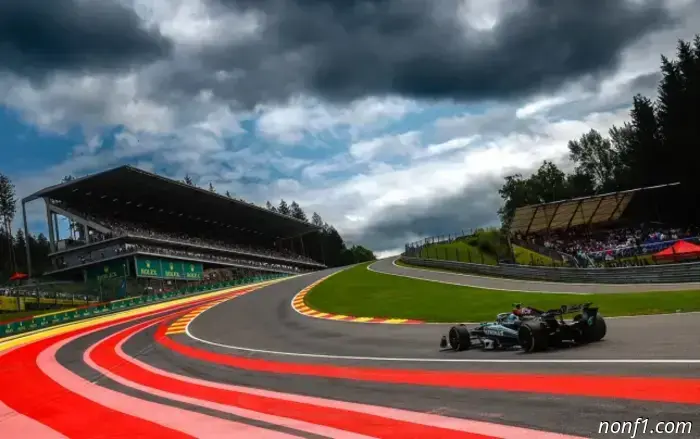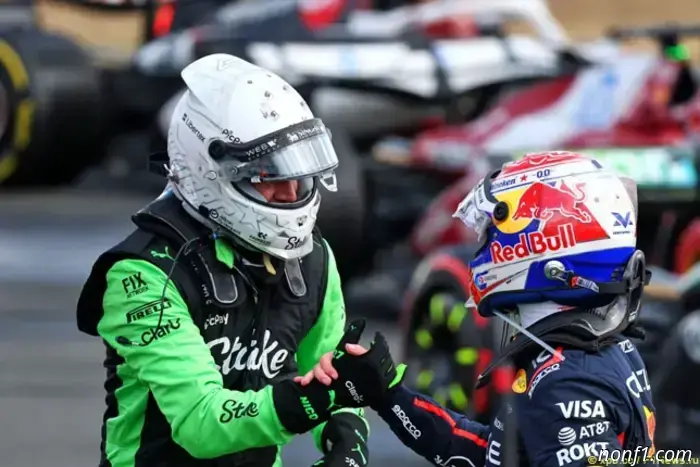
Spa Turns: From La Source to the Bus Stop
The Spa is preparing for the anniversary 70th Belgian Grand Prix, 57 of which have taken place on the classic circuit in Spa-Francorchamps, widely regarded as one of the best in the world of motorsport.
Surrounded by forests, the 7-kilometer track is located in the Ardennes mountains, characterized by high speeds and a very interesting, distinctive layout, which is why teams and drivers love this racetrack. Ahead of the Belgian round of the season, Mercedes decided to remind everyone of the origins of the names of its famous corners.
Turn 1 – La Source
The first turn of the circuit is also the slowest and is named after the numerous water springs abundant in this region of Belgium.
Historical moment: Since the acceleration from the start towards this turn is one of the shortest on the calendar, contact between cars often occurs in the braking zone before La Source.
In 2018, Fernando Alonso’s McLaren jumped into the air and literally flew over Charles Leclerc’s Sauber. Twenty years earlier, in 1998, one of the biggest accidents in F1 history occurred there, involving most of the grid.
Turns 2, 3, and 4 – Le Raidillon de l’Eau Rouge
Raidillon in French means "steep trail," and Eau Rouge means "red water."
This section, where the direction of travel changes from left to right, then the track curves slightly left again, with an incline reaching up to 15%, is one of the most famous in the world. Eau Rouge actually refers to a 15-kilometer stream flowing through the area, passing beneath the track at the foot of a hill. The water’s reddish color is due to high iron oxide content in the rocks at the bottom of the stream.
Historical moment: When Formula 1 cars thunder through this section at full speed, it’s a truly spectacular sight. Overtakes are rare, as drivers must change direction at nearly blind speeds. However, in 2011, Mark Webber successfully overtook Fernando Alonso's Ferrari on an outside line.
Turns 5 and 6 – Les Combes
The name of the chicane at the top of the hill at the end of the Kemmel straight translates to "the valley," likely because the track then descends into a valley. It’s also the name of the nearby hamlet situated next to the track.
Historical moment: In 2000, Mika Hakkinen performed the "overtaking of the century" here, passing Michael Schumacher’s Ferrari and taking the lead. The Finn, driving a McLaren, also included Ricardo Zonta’s car in his maneuver: Schumacher and Hakkinen caught up with the Brazilian's BAR, which was a lap behind, and Hakkinen astonishingly overtook both at once.
Turn 7 – Malmedy
This right-hand turn, after which the track continues deeper into the Ardennes forest, is named after the town of Malmedy, located about ten minutes from the circuit. It has a population of less than 13,000 but a rich history, having been founded in 648 AD and now protected as a historic site.
Turn 8 – Bruxelles/Rivage
Like Malmedy, it’s a local place name — a village near this right-handed corner. It’s quite long, and drivers feel it never quite ends, especially when the track is soaked with water. Recently, however, it has been called by the name of Belgium’s capital city.
Turn 9 – Speakers Corner
Many motorsport history books mention that this left turn has no official name, but it’s often called "the turn with loudspeakers."
This is because there is a mast with loudspeakers broadcasting the race.
Historical moment: On August 30, 1998, a famous collision occurred here involving Michael Schumacher and David Coulthard. The Scot deliberately slowed to let the leading Ferrari pass, but because of the spray on the track, Schumacher didn’t notice this and rear-ended a McLaren, leading to both cars retiring.
Turns 10 and 11 – Pouhon
The name continues the water-themed motif: this captivating double left corner is named after a mineral spring with iron-rich water.
Turns 12 and 13 – Fagnes
Another fast series of turns — right then left — named after a nature reserve in the Ardennes forest. But if you want to impress Belgians, it’s better to refer to them as Piff-Paff, a local term for the quick change of directions.
Turns 14 and 15 – Campus/Stavelot and Paul Frere
After navigating these two long right-handers, drivers approach the final section of the circuit, which is quite lively. The 14th turn was originally named after a small town 10 km from the track but has since been renamed in honor of the nearby automotive university.
Paul Frere was a renowned Belgian motorsport journalist and racing driver who competed in Formula 1 in the early 1950s. Racing for Ferrari, he finished second at Spa in 1956. His greatest achievement was winning the 24 Hours of Le Mans in 1960, also driving for Ferrari’s factory team.
Turns 16 and 17 – Blanchimont
This is another sequence associated with speed and adrenaline, named after a nearby hamlet.
Turns 18 and 19 – "Bus Stop"
This place used to have an actual bus stop until 2007, when the last section of the circuit ran along a public road.
Historical moment: Negotiating this chicane isn’t easy even on a dry track, and in the rain, it’s even more challenging. In 2010, Sebastian Vettel and Jenson Button collided on the wet asphalt here, and in 2008, Lewis Hamilton and Kimi Räikkönen nearly crashed — both incidents occurred in the rain, and that Belgian Grand Prix ended quite dramatically.

Spa Turns: From La Source to the Bus Stop
Ahead of the Belgian round of the season, Mercedes decided to remind everyone of what the names of the famous corners at Spa are associated with...

